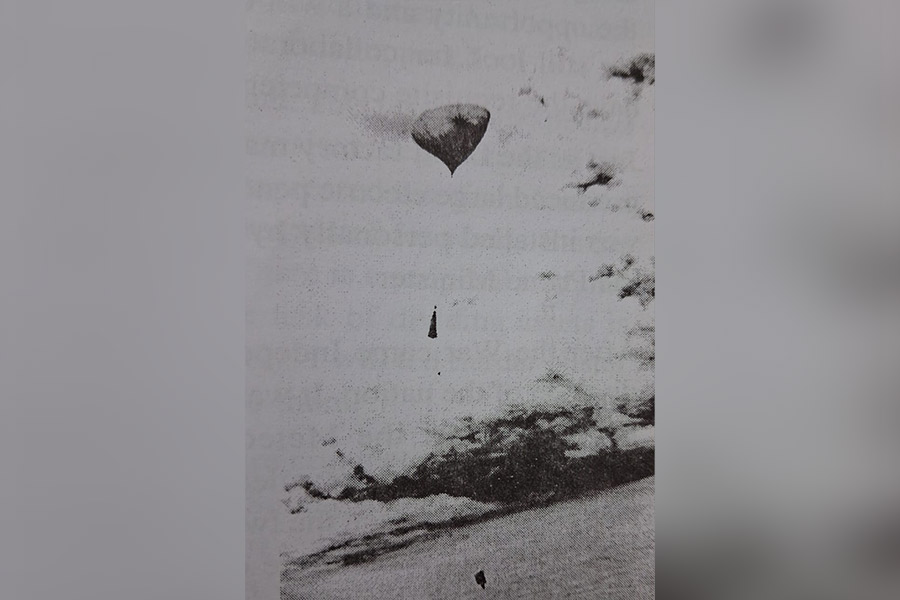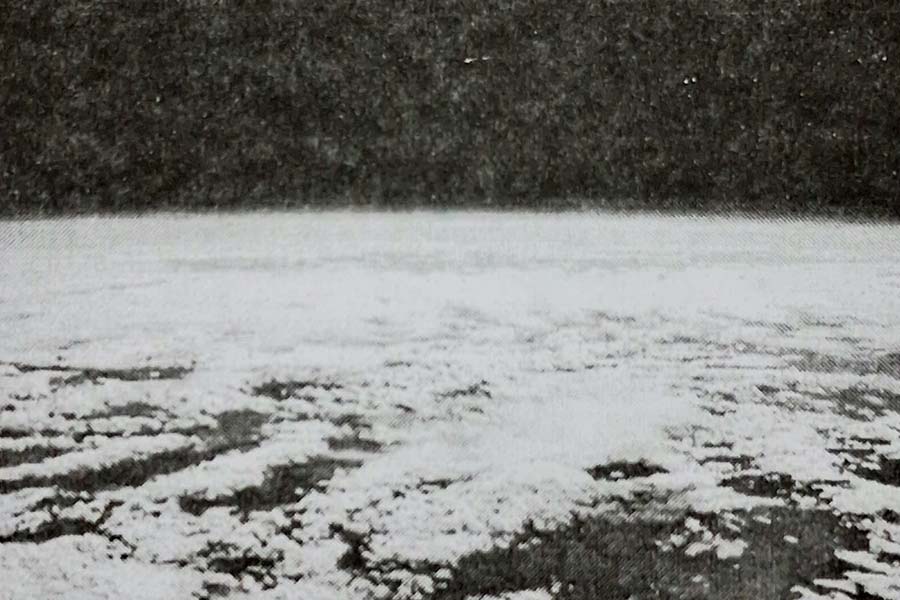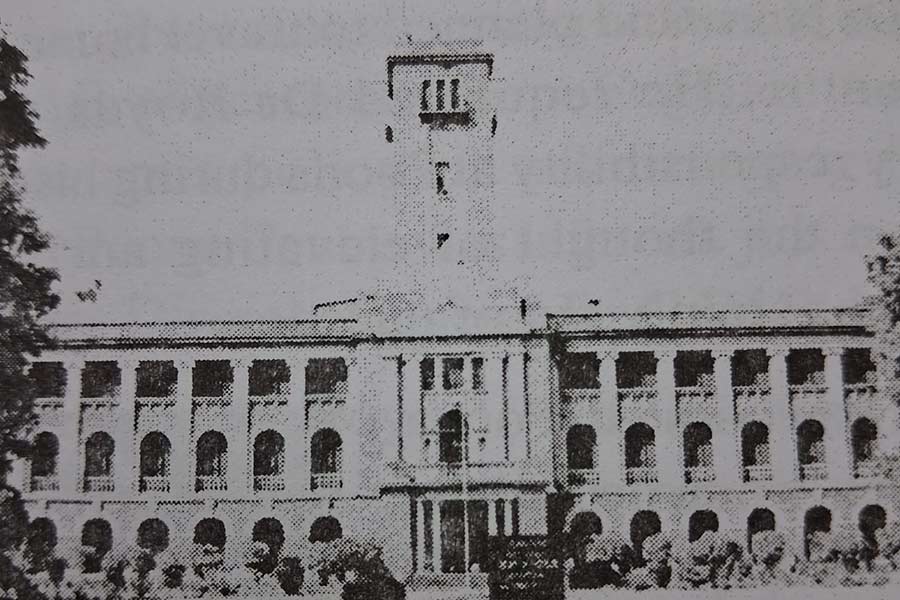The much-talked-about artificial rainfall experiment by the Delhi government in partnership with IIT Kanpur wasn’t India’s first cloud-seeding attempt. A Kolkata scientist carried out a similar experiment — with nearly 100 per cent success — over seven decades ago.
Dr Sudhanshu Kumar Banerji, the first Indian director general of the India Meteorological Department, lovingly called “Megh (cloud) Banerji” by his close ones, made it rain over Kolkata in 1952 with limited resources at the College of Engineering and Technology, Jadavpur.
High success rate with cost-effective measures

Sounding balloon used by Banerji in 1952
In the early 1950s, when cloud seeding was still a new concept even in the United States, Banerji began studying it closely. He had observed early experiments during a visit to the US and believed the process could be adapted and made more cost-effective in India.
At Jadavpur, he designed his own tall glass cloud chamber to simulate rainfall in controlled conditions. “He spent nearly two years conducting experiments in that chamber before moving to outdoor trials,” said his grandson Ranjan Banerji, now a 72-year-old engineering consultant and IIT Kanpur alumnus.
When the time came for field trials, hydrogen-filled balloons were fitted with small mechanisms that released silver iodide vapour, dry ice, and a controlled charge of gunpowder to disperse the seeding material. “He didn’t have access to aircraft, so he improvised using balloons, which he was already familiar with from his meteorological work,” Ranjan explained.
The results were dramatic for the time. “The experiments were successful almost every day,” Ranjan said. “In fact, the rainfall was sometimes so heavy that people in the surrounding areas complained about waterlogging.”
The successful trials were later presented at the Acharya Jagadish Chandra Bose Memorial Lecture at the Bose Institute and published by the Council for Scientific and Industrial Research (CSIR) in 1955 as Artificial Rainfall.
The scientist who loved improvising

Jadavpur University
Banerji’s journey began in Kolkata, where he studied mathematics at Presidency College and Calcutta University, later earning a D.Sc. He started teaching at Science College and worked as C.V. Raman’s first research assistant at the Indian Association for the Cultivation of Science.
Later, he joined the India Meteorological Department (IMD), eventually becoming the first Indian director general of Observatories in 1944. “He was more of an experimental scientist than a theoretical one,” Ranjan recalled. “He was deeply interested in instruments and in understanding how weather could be studied and predicted.”
During World War II, when imported meteorological instruments were unavailable, Banerji developed indigenous alternatives to keep the weather network running — his initiatives earned him the Order of the British Empire (OBE). After independence, Banerji represented India, and later Asia, at the World Meteorological Organization (WMO) under the United Nations.
When he retired in 1950, Banerji returned to teaching — joining the newly formed College of Engineering and Technology in Jadavpur as professor of mathematics. There, his curiosity led him back to experimentation, and to the pursuit of creating rain.
Working against the odds

Indian Meteorological Department
The project was done on a shoestring budget. “He didn’t receive funding from the Meteorological Department because they thought it was a waste of money,” Ranjan explained. “He got some support from the Scientific Research Council and Jadavpur Engineering College, but it was limited. So he built much of the setup himself.”
The balloons were made in Nagpur, while hydrogen was sourced locally. Using these modest means, he developed a method of seeding clouds from the ground — far cheaper than the aircraft-based methods being tried abroad.
The Indian Institute of Tropical Meteorology later acknowledged his work, noting that “the pioneering attempts in the field of rainmaking were made at Calcutta in 1952 by Dr S.K. Banerji. Even BBC News, in a 2023 report on Delhi’s cloud-seeding project, referred to Banerji as the first Indian climatologist to experiment with artificial rain.
After his experiments, the government transferred further research to the National Physical Laboratory (NPL) for large-scale development. Banerji, meanwhile, moved to Ratanpalli in Shantiniketan, where his neighbours affectionately called him “Megh Banerji” — the man who could make cloud rain.
The rainmaker lost to time

Cloud formation suitable for seeding
Much of this story might have been lost to time if not for his grandson. “My grandmother had written a biography of my grandfather in Bengali,” said Ranjan. “When I translated it into English, I came across many details of his rainmaking experiments. That’s when I began reaching out to institutions like the IMD to verify them.”
To his surprise, the IMD not only confirmed the information but had also preserved his legacy. “His photograph is displayed at the IMD headquarters in Delhi, and the conference room at the Alipore Regional Met Office in Kolkata is named after him,” Ranjan said.
He later presented copies of his grandmother’s translated biography to the IMD libraries across India, ensuring that the story of Dr S.K. Banerji of 3 Ramani Chatterjee Road, Ballygunge — the man who made it rain over Kolkata — would not be forgotten again.
“Artificial rain experiments are being done today with advanced technology,” Ranjan said. “But he was doing it with balloons and limited resources seventy years ago. He may not have had recognition in his lifetime, but the work he did was remarkable for its time.”
A legacy in the clouds

Indian Institute of Tropical Meteorology
As India once again turns to cloud seeding for answers — from drought relief to pollution control — the story of Dr S.K. Banerji remains an important chapter, reminding many of the power of curiosity and perseverance.
“He was a pioneer who believed in practical science,” said Ranjan. “He didn’t wait for the right conditions or funding. He simply found a way to make it work.”
And somewhere between Ballygunge and Shantiniketan, between his chalkboard equations and hydrogen balloons, India’s first rainmaker left a legacy that continues to ripple through the skies.

